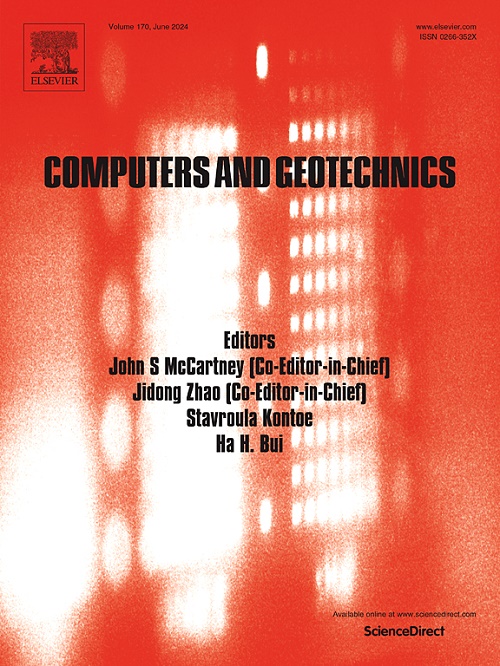A note on the stability of pressure-sensitive non-associated plasticity
IF 5.3
1区 工程技术
Q1 COMPUTER SCIENCE, INTERDISCIPLINARY APPLICATIONS
引用次数: 0
Abstract
Stability issues related to non-associated plastic flow still present an often overlooked cause for numerical difficulties in finite element simulations of cohesive-frictional materials. Despite their significance, only few examples with analytical solutions exist that clearly illustrate the nature of the problem. In this note, we extend the existing literature by deriving a novel closed-form analytical solution for the elastoplastic behavior of non-associated Drucker-Prager plasticity subjected to oedometric extension. Moreover, we demonstrate that structural softening can arise even though material softening is not encompassed by the perfectly plastic model. By means of stability analysis based on the acoustic tensor criterion, we show that structural softening is concomitant with the loss of ellipticity of the governing rate equilibrium equations. The obtained results are illustrated through a numerical experiment, which highlights the encountered numerical difficulties, including non-objectivity of the obtained results and snap-back behavior. By means of this strikingly simple example, we aim to raise awareness about the peculiarities of non-associated plasticity among researchers, students and practitioners of geotechnical engineering alike.
关于压敏非相关塑性稳定性的说明
与非相关塑性流动相关的稳定性问题仍然是黏聚摩擦材料有限元模拟中经常被忽视的数值困难的原因。尽管它们具有重要意义,但只有少数具有分析解决方案的例子清楚地说明了问题的性质。在这篇文章中,我们扩展了现有的文献,推导了非相关Drucker-Prager塑性在几何扩展下的弹塑性行为的一种新的封闭形式解析解。此外,我们证明,即使材料软化不包含在完全塑性模型中,结构软化也可能出现。通过基于声张量准则的稳定性分析,我们发现结构软化伴随着控制速率平衡方程的椭圆性损失。通过数值实验对所得结果进行了说明,突出了所遇到的数值困难,包括所得结果的非客观性和弹回行为。通过这个非常简单的例子,我们旨在提高研究人员、学生和岩土工程从业人员对非相关塑性特性的认识。
本文章由计算机程序翻译,如有差异,请以英文原文为准。
求助全文
约1分钟内获得全文
求助全文
来源期刊

Computers and Geotechnics
地学-地球科学综合
CiteScore
9.10
自引率
15.10%
发文量
438
审稿时长
45 days
期刊介绍:
The use of computers is firmly established in geotechnical engineering and continues to grow rapidly in both engineering practice and academe. The development of advanced numerical techniques and constitutive modeling, in conjunction with rapid developments in computer hardware, enables problems to be tackled that were unthinkable even a few years ago. Computers and Geotechnics provides an up-to-date reference for engineers and researchers engaged in computer aided analysis and research in geotechnical engineering. The journal is intended for an expeditious dissemination of advanced computer applications across a broad range of geotechnical topics. Contributions on advances in numerical algorithms, computer implementation of new constitutive models and probabilistic methods are especially encouraged.
 求助内容:
求助内容: 应助结果提醒方式:
应助结果提醒方式:


